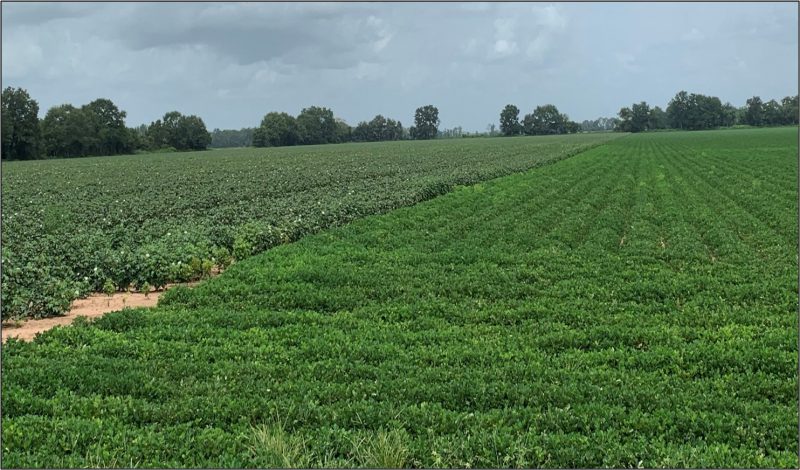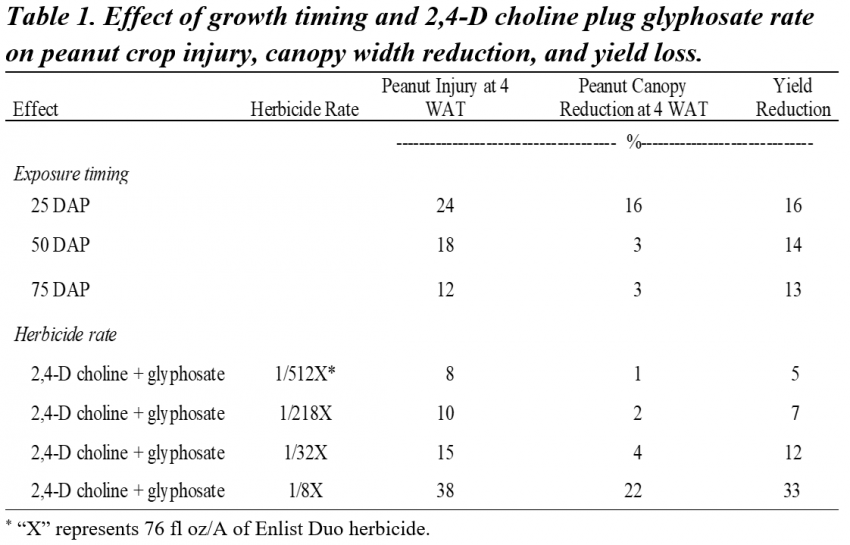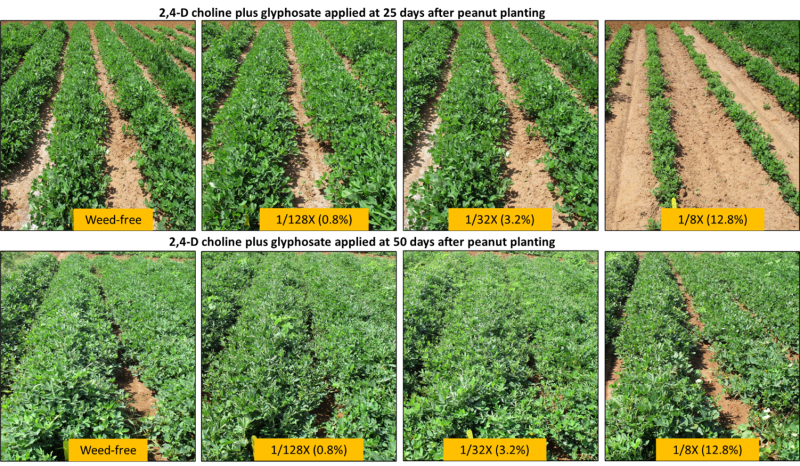
Peanuts planted next to a cotton field in the Florida Panhandle. Credit: Pratap Devkota, UF/IFAS West Florida Research and Education Center, Jay, FL.
Pratap Devkota, Weed Scientist, UF/IFAS West Florida Research and Education Center, Jay, FL
Peanut is commonly grown in close proximity to cotton and soybean fields in Florida Panhandle. So, there is potential for a peanut crop to be exposed to herbicides applied on Enlist cotton or soybean. For Enlist crops, Enlist Duo and Enlist One are the only labeled herbicide products that have 2,4-D choline. Currently, Enlist Duo (2,4-D choline plus glyphosate) is restricted for use in several counties in Florida (Brevard, Broward, Charlotte, Collier, DeSoto, Glades, Hardee, Hendry, Highlands, Hillsborough, Indian River, Jackson, Lee, Manatee, Martin, Miami-Dade, Okeechobee, Orange, Osceola, Palm Beach, Polk, Santa Rosa, Sarasota, and St. Lucie), but Enlist One (2,4-D choline) is allowed. So, Enlist One can be tank-mixed with Roundup or other allowed glyphosate products and applied on Enlist Crops for controlling problematic weeds.
Research was conducted at West Florida Research and Education Center in Jay, FL to determine peanut response to low rates (drift rates) of tank-mix of 2,4-D choline plus glyphosate. Herbicide was also applied at different peanut growth timing, i.e., at 25, 50, and 75 days after planting. The summary results on the peanut injury, canopy width reduction, and yield loss response are presented in the table below.

All four herbicides rates were applied at all three days after planting (DAP). The top of the table shows the average of the damage caused by all four herbicide rates for each of the three DAP. The bottom of the table shows average injury for each herbicide rate from all three DAP.
=
Response on peanut injury and yield
Peanuts exposed to 2,4-D choline plus glyphosate at 25 days after planting (i.e., at the vegetative growth stage) showed more injury compared to exposure at 50 or 75 days after planting (i.e., at pegging and pod development stages) (Table 1, Figure 1). A similar response was observed for peanut canopy width. However, the injury and canopy width reductions from exposure at 25 days after planting did not result in peanut yield reductions at the end of the season. Peanuts when exposed to Enlist Duo herbicide at various growth timing resulted in 16% or lesser yield loss. The results suggest that 2,4-D choline plus glyphosate drift that occurred on peanuts at an earlier growth timing (i.e., vegetative growth stage) could be more severe than drift that occurred at the later growth timings (i.e., pod formation and development stages).
Peanut injury response is highly dependent on the 2,4-D choline plus glyphosate drift rate. Peanuts exposed to 2,4-D choline plus glyphosate at a rate ≥1/32X resulted in more significant injury and yield reductions; however, a rate below 1/32X showed minimal impact on peanut injury and yield.
=

Peanut injury at 4 weeks after 2,4-D choline plus glyphosate exposure at 25 days after planting (top row) and 50 days after planting (bottom row). Credit: Pratap Devkota, UF/IFAS West Florida Research and Education Center at Jay, FL.
